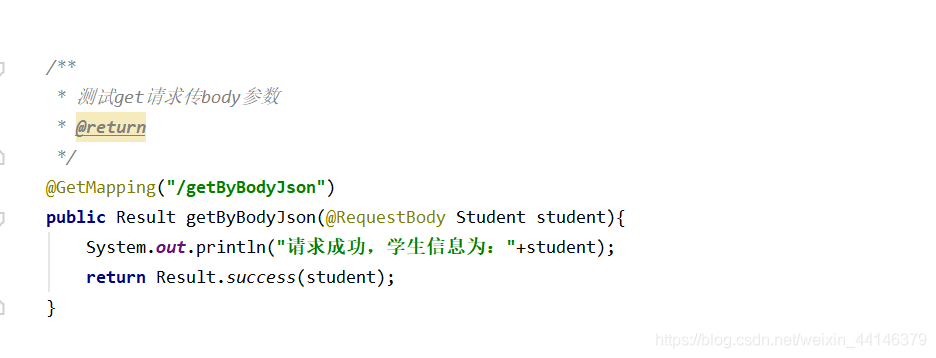前言
最近调用公司项目一个接口时,发现该接口是一个Get请求,入参在Body 中(json格式)。场景如下:A服务需发送http请求调用B服务的接口(该接口为Get方式,入参是一个json字符串在body中传递)
当我看到这个接口的时候,感觉好奇怪(MMP,干嘛不用POST请求。Get就get,请求还放Body中,心里有些不爽)尽管心里不爽,但是也只能默默接受,撸起袖子 “干” 就完了!
实现过程:
首先官方不推荐这样做,但是http(基于tcp的超文本传输协议)并没有规定,Get 请求不能加body
一.首先我写了一个Get请求接口,本地测试一下,便于大家直观的理解

调用成功:

本地使用postman调用是成功的,接下来我们使用Java代码请求调用
二.使用Http工具类调用Get请求(json参数)
1.引入httpclient 依赖
<!-- https://mvnrepository.com/artifact/org.apache.httpcomponents/httpclient -->
<dependency>
<groupId>org.apache.httpcomponents</groupId>
<artifactId>httpclient</artifactId>
<version>4.5.6</version>
</dependency>
2.定义一个HttpGet实体类
import org.apache.http.client.methods.HttpEntityEnclosingRequestBase;
import java.net.URI;
/**
* @author xf
* @version 1.0.0
* @ClassName HttpGetWithEntity
* @Description TODO 定义一个带body的GET请求 继承 HttpEntityEnclosingRequestBase
* @createTime 2020.11.18 13:51
*/
public class HttpGetWithEntity extends HttpEntityEnclosingRequestBase {
private final static String METHOD_NAME = "GET";
@Override
public String getMethod() {
return METHOD_NAME;
}
public HttpGetWithEntity() {
super();
}
public HttpGetWithEntity(final URI uri) {
super();
setURI(uri);
}
HttpGetWithEntity(final String uri) {
super();
setURI(URI.create(uri));
}
}
3.HttpGet请求公共方法
/**
* 发送get请求,参数为json
* @param url
* @param param
* @param encoding
* @return
* @throws Exception
*/
public static String sendJsonByGetReq(String url, String param, String encoding) throws Exception {
String body = "";
//创建httpclient对象
CloseableHttpClient client = HttpClients.createDefault();
HttpGetWithEntity httpGetWithEntity = new HttpGetWithEntity(url);
HttpEntity httpEntity = new StringEntity(param, ContentType.APPLICATION_JSON);
httpGetWithEntity.setEntity(httpEntity);
//执行请求操作,并拿到结果(同步阻塞)
CloseableHttpResponse response = client.execute(httpGetWithEntity);
//获取结果实体
HttpEntity entity = response.getEntity();
if (entity != null) {
//按指定编码转换结果实体为String类型
body = EntityUtils.toString(entity, encoding);
}
//释放链接
response.close();
return body;
}
4.运行服务,本地测试调用一下该接口
/**
* 测试 Get 请求
*/
@Test
public void test(){
String url = "http://127.0.0.1:8012/export/getByBodyJson";
Map<String, Object> map = new HashMap<>();
map.put("stuName","张一山");
map.put("school","北京戏剧学院");
String reqParams = JSONArray.toJSON(map).toString();
try {
String s = sendJsonByGetReq(url, reqParams, "UTF-8");
System.out.println("请求Get请求返回结果:"+s);
} catch (Exception e) {
e.printStackTrace();
}
}
三.使用HttpGet请求发送body入参调用成功

尽管这样解决了get 加body 体传参,但是仍建议大家使用post 加body!